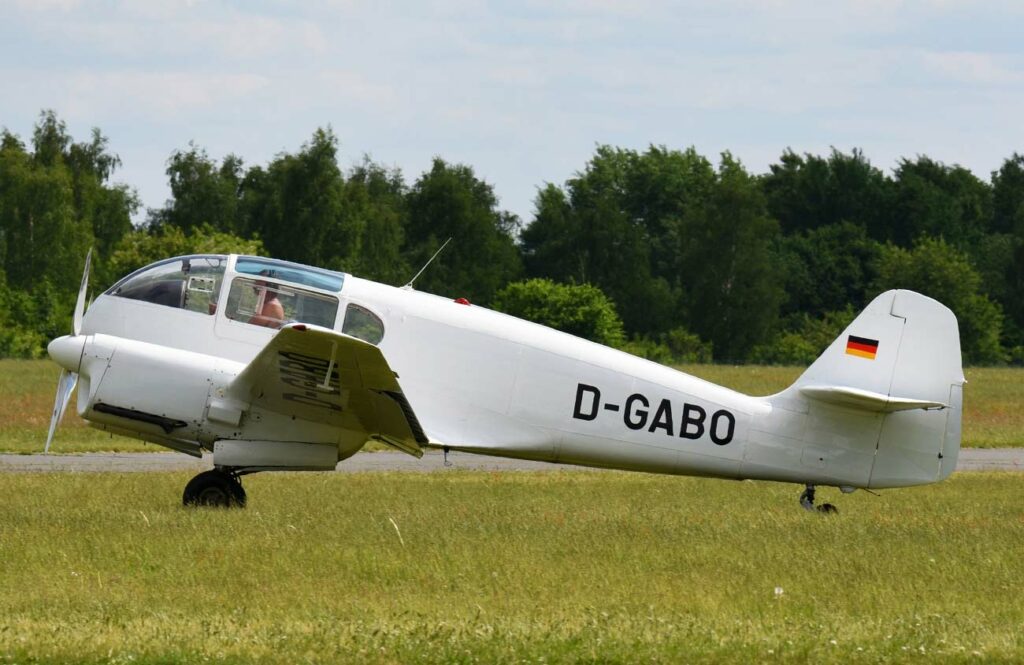The Aero Ae-45, a Czechoslovakian light twin-engine aircraft, excelled in utility and training roles with its remarkable durability and efficiency.
The Aero Ae-45, a pioneering post-WWII Czechoslovakian aircraft, marked a significant evolution in light aviation. Designed by Ing. Kašpar and Ing. Beneš in the late 1940s, it was the first Czech aircraft to gain significant export success in the West. This twin-engine, low-wing monoplane was renowned for its robust construction, reliability, and versatility. Its design catered to a variety of roles, including transportation, training, and light utility. With its all-metal airframe, the Ae-45 was ahead of its time, offering impressive performance and operational efficiency. Its notable features included good handling, a spacious cabin, and efficient fuel consumption, making it a favorite among small operators and flying clubs. Its legacy is evident in the continued use of its design principles in modern light aircraft.
The Aero Ae-45 is a symbol of innovative aircraft design and a testament to the technological advancements of its era.
History of the Development of the Aero Ae-45
The Aero Ae-45’s story begins in the late 1940s, a period marked by rapid advancements in aviation technology. Post-World War II Europe was in a phase of reconstruction and technological progress, and the aviation industry was no exception. Czechoslovakia, with a rich aviation history, sought to create an aircraft that would not only meet domestic needs but also appeal to international markets.
The Aero Ae-45 was developed by Ing. Antonín Kašpar and Ing. Jiří Beneš, who were tasked with designing a light, twin-engine aircraft that could serve multiple roles, including transportation, training, and liaison duties. Launched under the auspices of the Aero Vodochody company, the program aimed to showcase Czechoslovakia’s engineering prowess and contribute to the country’s economic recovery.
First flown on July 21, 1947, the Aero Ae-45 immediately garnered attention for its performance and design. It was not just a product of its time but a forward-thinking creation that set new standards in light aircraft design. Its success was further cemented at the 1949 Paris Air Show, where it won several awards and attracted international buyers.
The Aero Ae-45 did not have an official NATO nickname, as it was primarily used in civilian and non-combat roles.
Design of the Aero Ae-45
The Aero Ae-45’s design was a harmonious blend of functionality and innovation. It featured a low-wing monoplane layout with a retractable tricycle undercarriage, making it advanced for its time. The all-metal airframe was both durable and lightweight, with a length of 26.25 feet (8 meters) and a wingspan of 44.29 feet (13.5 meters).
Powering the Ae-45 were two Walter Minor 4-III engines, each producing 105 horsepower. This setup provided a balance of power and fuel efficiency, allowing for a maximum speed of 230 mph (370 km/h) and a cruising speed of 174 mph (280 km/h).
The aircraft’s interior was designed with comfort and practicality in mind. It could accommodate four persons, including the pilot, and had ample space for luggage, making it ideal for business travel and flight training.
One of the key advantages of the Ae-45 was its operational versatility. It could be easily adapted for various roles, including aerial photography, ambulance services, and light cargo transport. However, its reliance on specific engine parts and maintenance expertise were some drawbacks, limiting its widespread adoption in regions without adequate support infrastructure.

Performance of the Aero Ae-45
The performance characteristics of the Aero Ae-45 were impressive for its class. The twin-engine configuration provided a reliable and robust power source, ensuring safety and efficiency.
The engines, each generating 105 horsepower, allowed the Ae-45 to achieve a maximum speed of 230 mph (370 km/h) and a cruising speed of 174 mph (280 km/h). The aircraft had a service ceiling of 19,685 feet (6,000 meters) and a range of 621 miles (1,000 kilometers), making it suitable for medium-range flights.
Compared to contemporaries like the Beechcraft Bonanza, the Ae-45 offered comparable performance but stood out for its twin-engine reliability and versatility. Its operational costs and maintenance requirements were also competitive, making it a popular choice among small operators.
Military Use and Combat of the Aero Ae-45
The Aero Ae-45, primarily designed for civilian purposes, had limited military application. However, it was used by several countries for training, liaison, and light transport roles. The aircraft’s ease of handling and reliability made it an ideal choice for these non-combat missions.
While the Ae-45 did not have any armament or combat roles, its utility in various military operations was noteworthy. It was used for reconnaissance, communication, and as a training aircraft for pilots transitioning to larger, more complex planes.
The Aero Ae-45 was exported to several countries, including Hungary, Poland, and even some Western nations, demonstrating its international appeal. Its military use was predominantly confined to training and liaison roles, given its non-combat design.
The aircraft remained in service for several decades, eventually being phased out as newer, more advanced aircraft became available. Its replacement varied depending on the specific needs and resources of the operating countries.
The Aero Ae-45 remains a significant aircraft in the history of aviation. Its innovative design, reliable performance, and versatile applications set it apart in the post-WWII era. While it may not have been a combat aircraft, its contribution to the development of light aviation and its role in various military capacities cannot be overlooked. The Ae-45 is a testament to the ingenuity and skill of Czechoslovakian aviation engineering, leaving a lasting legacy in the world of aviation.
Back to Transport planes.